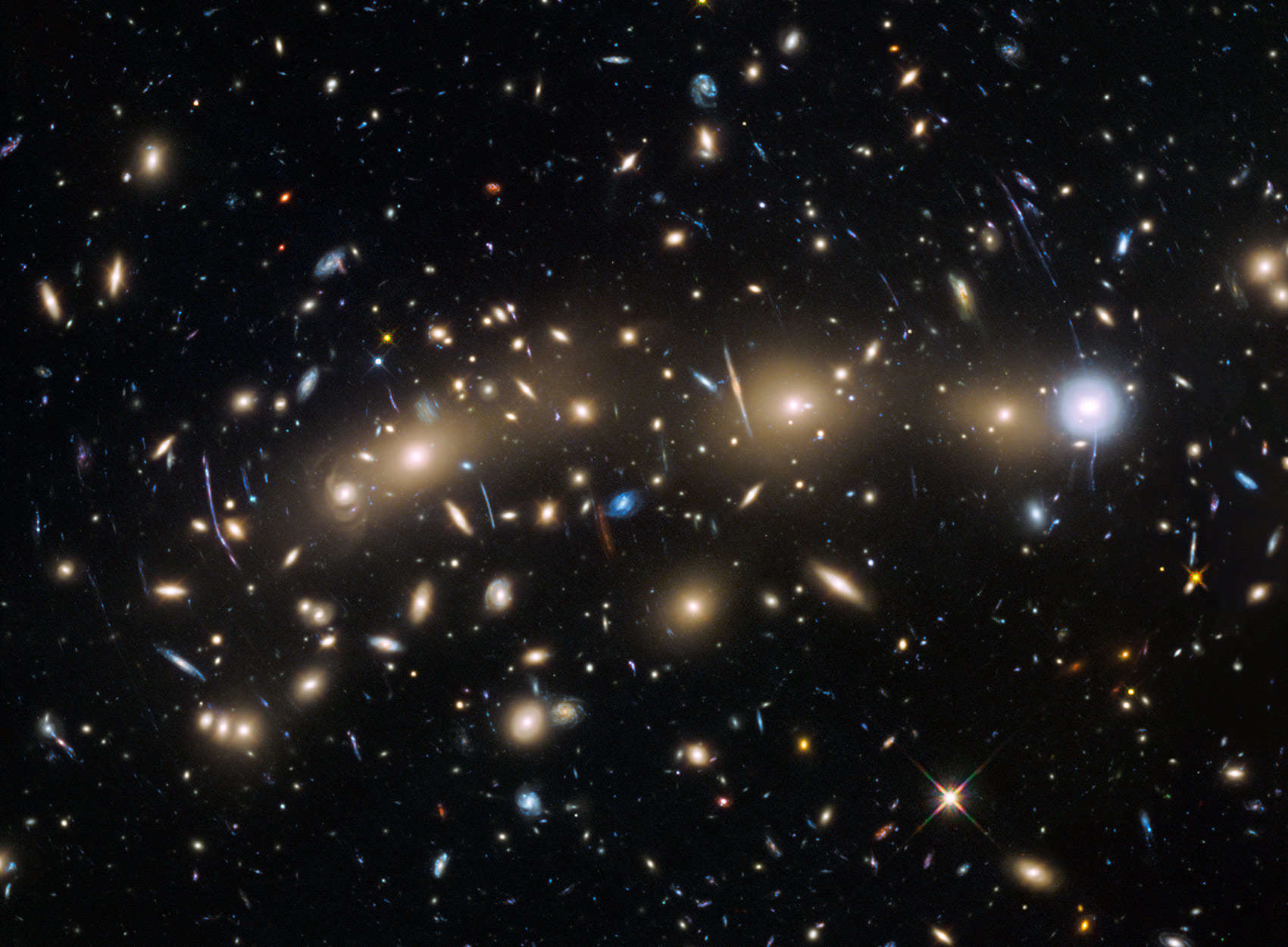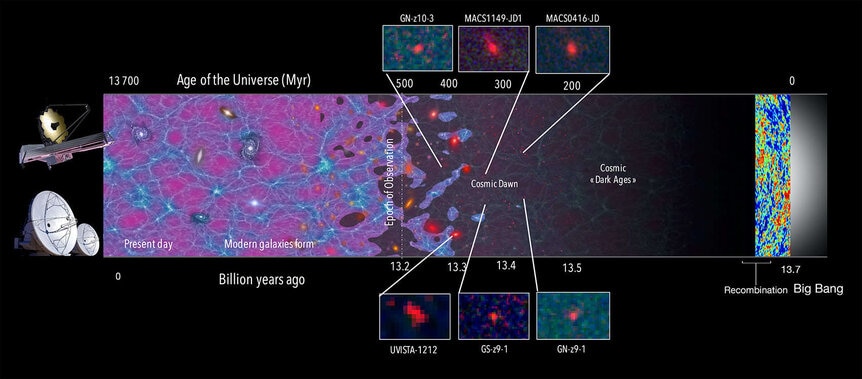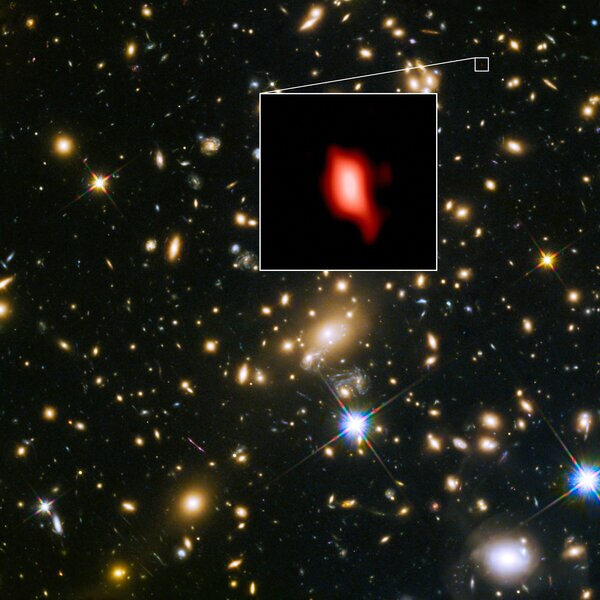Create a free profile to get unlimited access to exclusive videos, sweepstakes, and more!
Seeing stars born at the dawn of the Universe

Astronomers have found six galaxies that look to be at the thin hairy edge of the observable Universe, so far away that we see them not long after their very first stars were born — the cosmic dawn.
Incredibly, just seeing stars in them at all means we can learn about what they were like even earlier in their history, perhaps around 100 million years after the birth of the Universe itself!
There are two key physical properties of the Universe needed to make an observation like this. One is that the speed of light is finite, so that when we see galaxies 13 billion light years away (say) we see them as they were when they were young — it’s taken that light 13 billion years to reach us. The Universe is only about 13.8 billion years old, so we’d see a galaxy like that 800 million years after the birth of the cosmos.
The other is that the Universe is expanding. A galaxy that far away is moving away from us very rapidly. Because of the Doppler shift, the light from that galaxy is shifted to longer wavelengths, what we call redshift. Astronomers use a handy term for redshift designated by the letter z. A z = 1 means the wavelength of an object is shifted to (z+1) = 2 times its original wavelength (what we call the rest wavelength). An object at z = 4 has a wavelength 5 times the original, and so on. It’s a shorthand notation that’s convenient; the distance to an object depends on its redshift but in a somewhat complicated way (it depends on how rapidly the Universe expands, how much matter and energy is in it, and so on) so this avoids complications, and is a purely observational measurement.
Some very bright galaxies called quasars have been seen out to tremendous distance, like z = 7.6*. But these are unusual objects, so fantastically bright they’re easier to find. What about normal galaxies, ones more like our own?
The astronomers in the new study took advantage of some quirks in physics to find these quieter galaxies. Suppose you have a galaxy at z = 9. It’s already a few hundred million years old. It formed a huge pile a stars right off, then ran out of fuel. The most massive of those stars, the fiercest and brightest, explode as supernovae after a few million years, and go away. What’s left are lower mass ones, still bright but not supernova candidates. We call these A-type stars.
These stars have lots of hydrogen in their outer layers, as all stars do. This part is tricky: Light bluer than about 365 nanometers (for example, in the ultraviolet) has enough energy to blow the electron in a hydrogen atom clean away from the nucleus. So hydrogen loves to absorb those photons. If we look at stars like this, we see some blue light from them, but anything bluer than 365 nm is much weaker. Light redder than this we still see well. This sudden jump in color is called the Balmer break or Balmer jump.
But this example galaxy is at z = 9, so the light we see from it is redshifted by a factor of 10, to 3650 nanometers. That’s infrared light, and this is where it gets fun: the Spitzer Space Telescope had two filters in one of its cameras; one that saw infrared light at 3,650 nm and another that saw 4,500 (in better units that’s 3.6 and 4.5 microns). This can be used to spot these distant galaxies! If you see a faint smudge of a galaxy that’s brighter in 4.5 than 3.6 microns, it may be one of these quiet galaxies with a Balmer break. The brightest stars are gone, leaving behind the A-type stars, and they appear brighter at redder light due to that photon absorption by hydrogen.
So that’s what astronomers looked for. Going through the Spitzer data they found six galaxies that fit the bill, and were likely at z = 9 or more. But how to confirm? One way is to take spectra, breaking the incoming light into many colors, and look for the redshift more carefully. That’s hard because these galaxies are faint, but they did for one called GN-z-10-3, which was at z = 8.78. They also found another one called MACS0416-JD which they think is likely at z = 9.28. That one happened to be behind a galaxy cluster that’s much closer to us, and happily its light was gravitationally lensed by the cluster, making it appear much brighter, so it was easier to measure (for an explanation of how that works, see this article I wrote about a different such galaxy and cluster). Another galaxy, MACS1149-JD16, was previously observed by this same team, and I have the details of that from their earlier paper.
The other galaxies were more difficult to measure, but the scientists think they too are incredibly far away at z > 9.
This is an astonishing achievement. These galaxies are far. Using relatively conservative numbers to convert those redshifts into distances, a z of 8.78 is a little less than 13.3 billion light years, and z = 9.28 is over 13.4 billion!
That is stunning to me. Twenty years or so ago, I worked on a Hubble project trying to detect light from z = 7, and we couldn’t do it (at least not by the time I left the project); now we can reliably see galaxies hundreds of millions of light years more distant.
… but there’s more, and this is the part that made the hair on the back of my neck stand up. Remember, we’re seeing stars in these galaxies that were already a couple of hundred million years old when they emitted the light we see. So just by detecting this light we are learning about the way stars formed in these galaxies even further in the past. The scientists find that these galaxies (on average) had already formed about 70% of their stars at z = 10, so they were forming some of these stars when the Universe was less than 200 million years old!
That’s phenomenal. This time in the Universe is difficult to observe (it’s referred to as the “cosmic dark ages”) so being able to learn about it, even if inferred from what happened somewhat later, is important. We’re edging closer to seeing the time the very first stars, ever, were born.
Amazing. Simply, and wonderfully, amazing.
*CORRECTION: I originally wrote the most distant known quasar (in that link) has a redshift of 11, but it's at 7.64. The most distant confirmed galaxy is at z=11 and is an unusually bright one.

















